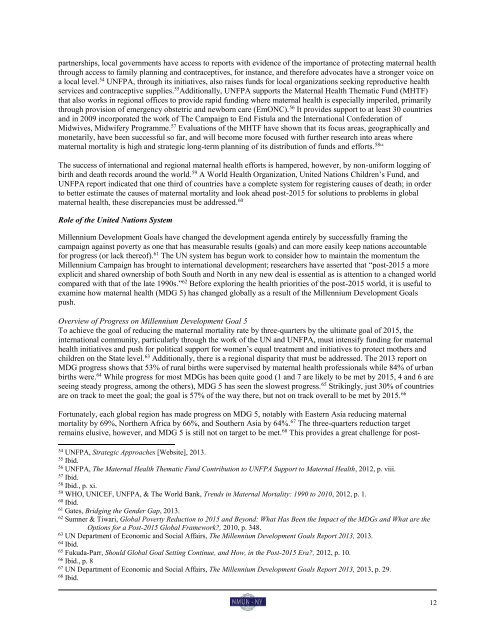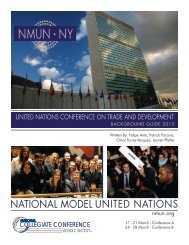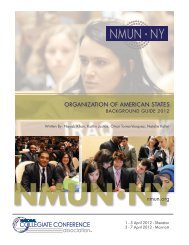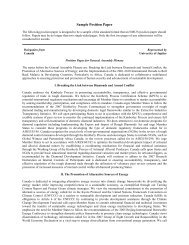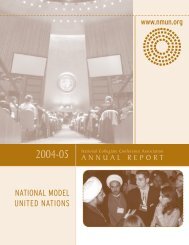UNFPA Background Guide - National Model United Nations
UNFPA Background Guide - National Model United Nations
UNFPA Background Guide - National Model United Nations
You also want an ePaper? Increase the reach of your titles
YUMPU automatically turns print PDFs into web optimized ePapers that Google loves.
partnerships, local governments have access to reports with evidence of the importance of protecting maternal health<br />
through access to family planning and contraceptives, for instance, and therefore advocates have a stronger voice on<br />
a local level. 54 <strong>UNFPA</strong>, through its initiatives, also raises funds for local organizations seeking reproductive health<br />
services and contraceptive supplies. 55 Additionally, <strong>UNFPA</strong> supports the Maternal Health Thematic Fund (MHTF)<br />
that also works in regional offices to provide rapid funding where maternal health is especially imperiled, primarily<br />
through provision of emergency obstetric and newborn care (EmONC). 56 It provides support to at least 30 countries<br />
and in 2009 incorporated the work of The Campaign to End Fistula and the International Confederation of<br />
Midwives, Midwifery Programme. 57 Evaluations of the MHTF have shown that its focus areas, geographically and<br />
monetarily, have been successful so far, and will become more focused with further research into areas where<br />
maternal mortality is high and strategic long-term planning of its distribution of funds and efforts. 58 “<br />
The success of international and regional maternal health efforts is hampered, however, by non-uniform logging of<br />
birth and death records around the world. 59 A World Health Organization, <strong>United</strong> <strong>Nations</strong> Children’s Fund, and<br />
<strong>UNFPA</strong> report indicated that one third of countries have a complete system for registering causes of death; in order<br />
to better estimate the causes of maternal mortality and look ahead post-2015 for solutions to problems in global<br />
maternal health, these discrepancies must be addressed. 60<br />
Role of the <strong>United</strong> <strong>Nations</strong> System<br />
Millennium Development Goals have changed the development agenda entirely by successfully framing the<br />
campaign against poverty as one that has measurable results (goals) and can more easily keep nations accountable<br />
for progress (or lack thereof). 61 The UN system has begun work to consider how to maintain the momentum the<br />
Millennium Campaign has brought to international development; researchers have asserted that “post-2015 a more<br />
explicit and shared ownership of both South and North in any new deal is essential as is attention to a changed world<br />
compared with that of the late 1990s.” 62 Before exploring the health priorities of the post-2015 world, it is useful to<br />
examine how maternal health (MDG 5) has changed globally as a result of the Millennium Development Goals<br />
push.<br />
Overview of Progress on Millennium Development Goal 5<br />
To achieve the goal of reducing the maternal mortality rate by three-quarters by the ultimate goal of 2015, the<br />
international community, particularly through the work of the UN and <strong>UNFPA</strong>, must intensify funding for maternal<br />
health initiatives and push for political support for women’s equal treatment and initiatives to protect mothers and<br />
children on the State level. 63 Additionally, there is a regional disparity that must be addressed. The 2013 report on<br />
MDG progress shows that 53% of rural births were supervised by maternal health professionals while 84% of urban<br />
births were. 64 While progress for most MDGs has been quite good (1 and 7 are likely to be met by 2015, 4 and 6 are<br />
seeing steady progress, among the others), MDG 5 has seen the slowest progress. 65 Strikingly, just 30% of countries<br />
are on track to meet the goal; the goal is 57% of the way there, but not on track overall to be met by 2015. 66<br />
Fortunately, each global region has made progress on MDG 5, notably with Eastern Asia reducing maternal<br />
mortality by 69%, Northern Africa by 66%, and Southern Asia by 64%. 67 The three-quarters reduction target<br />
remains elusive, however, and MDG 5 is still not on target to be met. 68 This provides a great challenge for post-<br />
54<br />
<strong>UNFPA</strong>, Strategic Approaches [Website], 2013.<br />
55<br />
Ibid.<br />
56<br />
<strong>UNFPA</strong>, The Maternal Health Thematic Fund Contribution to <strong>UNFPA</strong> Support to Maternal Health, 2012, p. viii.<br />
57<br />
Ibid.<br />
58<br />
Ibid., p. xi.<br />
59<br />
WHO, UNICEF, <strong>UNFPA</strong>, & The World Bank, Trends in Maternal Mortality: 1990 to 2010, 2012, p. 1.<br />
60<br />
Ibid.<br />
61<br />
Gates, Bridging the Gender Gap, 2013.<br />
62<br />
Sumner & Tiwari, Global Poverty Reduction to 2015 and Beyond: What Has Been the Impact of the MDGs and What are the<br />
Options for a Post-2015 Global Framework?, 2010, p. 348.<br />
63<br />
UN Department of Economic and Social Affairs, The Millennium Development Goals Report 2013, 2013.<br />
64<br />
Ibid.<br />
65<br />
Fukuda-Parr, Should Global Goal Setting Continue, and How, in the Post-2015 Era?, 2012, p. 10.<br />
66<br />
Ibid., p. 8<br />
67<br />
UN Department of Economic and Social Affairs, The Millennium Development Goals Report 2013, 2013, p. 29.<br />
68<br />
Ibid.<br />
12


